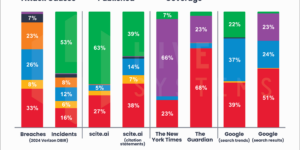When the president of Aon attended the Rendez-Vous de Septembre, he came away with a forecast hidden behind the words reinsurers were explicitly delivering.
“Each of the reinsurers led every meeting with, ‘We really like where we are in the market. We don’t really think that prices should come down. Or attachment points…But we want to grow,'” said Eric Andersen, reporting the words he actually heard.
“As soon as a broker hears ‘we want to grow,’ that’s the end of the pricing cycle from an upward standpoint because it’ll be new to them,” Andersen said, giving his translation of the messages coming out of the annual gathering of reinsurance, carrier and broker executives.
Andersen shared that assessment during a presentation at the KPMG 36th Annual Insurance Industry Conference last week. Later he explained the genesis of high retentions to KPMG U.S. Insurance Sector Leader Scott Shapiro and insurance financial executives in attendance.
Going back in time, Andersen said, reinsurers were paying out losses on primary perils, he said, referring to hurricanes, earthquakes and other “traditional things that the reinsurance industry was kind of built to handle on the property side.”
“Florida got pounded a couple of times. You’ve got typhoons in Japan…They’re losing money,” he said, painting a word picture of the state of the industry five-to-seven years ago. “And so they react pretty aggressively and they do two things. They raise the attachment points for where they come in to support the primary insurers, and they double the price.”
“In the end, when you look back on it, the more meaningful thing was the attachment point,” he said, explaining that since those structural changes were put in place, there’s been “a quirk of the weather,” fueling secondary perils: Not hurricanes or earthquakes, but “hail, flood in Germany, flood in Dubai, hail in the U.S., wildfires in California. [And] none of that hit the attachment points of the reinsurers.”
“So if you’re a reinsurer today, you are making significant returns to a point where you only want to talk about liability risk,” he said, reporting that most of the conversations at Monte Carlo centered on casualty reinsurance issues.
On property, “the primary insurers are bearing all of those secondary losses. So if you follow the earnings calls of the primary P/C markets, all you’ll see are one-time charges each quarter as they deal with these secondary perils,” Andersen continued. For the primary carriers, “there is this battle that is brewing going into next year around who bears the loss of the volatility.”
“Do the reinsurers come down and essentially take some of these secondary perils to support the primary insurers? Or do the primary insurers have to eat those at which point the price—our prediction is the [reinsurance] price is going to collapse because it’s not worth what’s being sold today based on the structure.”
“We do think at the end of this negotiation season, which ends on January 1, you will see more volatility protection, which will allow the insurers to be more aggressive in terms of growing their client bases,” he concluded.
Let’s Grow
Separately, during a post-Monte Carlo panel discussion hosted by the reinsurance side of Aon a week before the KPMG conference, three reinsurance executives delivered the same types of growth messages that Andersen said he heard at the Rendez-Vous. While all three confirmed that they are likely to grow their property books—even as the pricing environment becomes more competitive—two indicated that structural changes on property programs weren’t up for discussion. Casualty, they said, remained an area where increasing dialogue and transparency into insurers’ claims and underwriting practices will be needed to support growth, they said.
“The areas of growth for us [are] pretty broad this year, and very consistent with last year… We’re really looking to continue to grow on the property side,” said Philippe Meyenhofer, chief executive officer of PartnerRe Ltd., responding to a question about the reinsurance company’s risk appetite from Moderator Andy Marcell, chief executive officer of Risk Capital and Risk Solutions at Aon.
PartnerRe is also expanding business in specialty classes. “The only area of note where we’re looking to probably stay flattish is on the casualty side for the obvious reason. That’s very margin- and data- dependent,” Meyenhofer reported.
Read more of what the reinsurance executives had to say about their casualty appetites in the related article, “Reinsurers ‘Open for Business’—Even U.S. Casualty, Execs Say“
“We want to continue to grow with our clients,” agreed David Marra, executive vice president and group chief underwriting officer for RenaissanceRe. “We don’t plan growth for growth’s sake, but if we continue to be a good reinsurance partner, growth will be a favorable outcome when it makes sense. “The one area that we are digging deeper into is U.S. casualty,” RenRe’s CUO said, indicating the reinsurer’s increasing focus on loss costs trends, which could accelerate in 2025.
“We have appetite to continue to grow property-cat,” Marra stated. “We have capital adequacy. We have retained earnings and that we’re willing to deploy into the business. We’re comfortable with where the market’s trading….We think the pendulum has swung close to the middle. Rates are at an adequate, attractive level,” he continued.
“We also like the way structures and retentions are very focused on the capital level of the stack. That is the right place for a reinsurer to be deploying capacity. And as clients continue to grow their programs, … we’re open for business to continue to engage with them and grow our own support,” he said, noting there was significant growth in 2024.
Restating what Marra meant by his reference to the “capital level of the stack,” and agreeing with the approach, Meyenhofer said, “When it comes to the structures, particularly the attachment points, those readjustments that occurred two years ago… were very necessary. And I think everybody’s looking to those to hold. Repeating Marra’s phrasing, he said the higher position is the “more sustainable level where reinsurers should play.”
Silke Sehm, a member of the executive management board of Hannover Re, believes that cedent struggles with high attachment points open up an opportunity for some reinsurers to offer structured solutions.
“We would like to grow on the one side, on the traditional accounts, with our clients together. And at the same time, [we] have a strong focus on the solutions,” she said. “We would like to be the first call when it comes to volatility cover, to individual solutions, innovative solutions—be it on the structured reinsurance side, on the ILS side or parametric coverage.”
Expanding on the traditional reinsurance growth prospects, Sehm said the rate level of natural catastrophe business “is currently at a very good disciplined level.”
“We have a strong balance sheet at Hannover Re and therefore, we would like to grow together with our clients, and we are prepared for that.”
Referring to protection gaps, the higher retentions being accepted by cedents, and the total scarcity of aggregate cover in the property reinsurance market, Sehm said there is demand for innovation. “This has given us the opportunity to…work on structured reinsurance solutions to cope with that volatility in the individual balance sheet[s], to smooth certain results over a couple of years,” she said.
“It doesn’t matter who the client is, what the name on the door is. We’re just going to put up the prices that we think are commensurate for the risk that we’re taking on. “
Philippe Meyenhofer, PartnerRe
Intrigued by Sehm’s idea, Meyenhofer agreed that “there is a lot of frequency, which [cedents] might want to manage there in a structured fashion. He added, “I think what you’re hearing is that there isn’t going to be a lot of competition on the attachment points because everybody, I think at least on this call, seems to view this [higher level] as the rational reset following rampant inflation.”
“[But] there is price competition during every renewal. That needs to be the case, and that will be the case this year as well,” he said, leading into a response to a question from Marcell about whether PartnerRe might be approaching regionals, national and global accounts differently as price competitiveness emerges in the property reinsurance market.
“Our view of risk doesn’t change depending on the client. We make it our business to have view of risk on the main perils that we trade in, and we have our hurdle rates just like David will have, Silke will have. Those are the prices that we put up. It doesn’t matter who the client is, what the name on the door is. We’re just going to put up the prices that we think are commensurate for the risk that we’re taking on.”
Marcell, focusing his attention on his national and regional clients, advocated for more “sideways cover” from reinsurers at two recent Aon events, including last week’s panel discussion. (Examples might include lower-cost provisions to reinstate limits following a loss to protect against the possibility of multiple events, higher occurrence limits under quota share contracts, and greater availability of dropdown and aggregate protection under which reinsurers would take back some of the volatility now being retained by cedents, Aon said.) “When you think of delivering value to insurance companies—how do you think about that?” Marcell asked the panel, pushing them to consider reinsurance coverages that will afford regionals greater financial stability.
“In terms of how we think about the value proposition against the backdrop of a lot of uncertainty and change, I mean that is our business. That is really the proposition we have,” Meyenhofer said. Referring to PartnerRe’s solid balance sheet and prudent risk management, he said both allow the reinsurer to “take on risk in a sustainable fashion. “We are going to be thoughtful and careful in terms of how we construct the portfolio so our clients can rely on us actually paying the claims,” he said. “The price is what you pay, but value is what you get. So we are very focused on being able to deliver when it’s time to pay.”
Expanding on the value question, Meyenhofer spoke about how reinsurers’ deliver value to brokers by setting their appetites and views of risk, “and then behaving predictably, quoting, [and] putting up capacity” to transfer risk.
Addressing Marcell’s “sideways cover” wish directly, Meyenhofer said PartnerRe offered an aggregate product last year that didn’t get a lot of traction. “We did discuss whether we should dust it off and wheel it out there again. We chose not to but it’s in the warehouse. We can bring it out….
“And we do sell quota shares. That’s the ultimate frequency solution,” he said.
Meanwhile, Sehm said Hannover Re currently offers €6 billion in structured reinsurance solutions, some of which are structured quota shares. “These are also spread loss, excess of loss. These are also multiline stop-loss treaties. But with that volume and a good diversification in our book, all of those transactions are different from each other,” she said.
“It really starts with listening to the individual challenges of the client” rather than with a product discussion, she said.
Offering takeaways for his clients, Marcell said, there’s a price for anything, but there are solutions to address the challenges they faced in 2023 and 2024 from increased severe convective storm losses or other drivers of retained volatility. “But the key for Hannover and [PartnerRe] is having those conversations early and being clear on what it is that you want to achieve,” he said.





















 Reporter’s Notebook: ‘Nobody Else Does Telematics,’ Lemonade Exec Says
Reporter’s Notebook: ‘Nobody Else Does Telematics,’ Lemonade Exec Says  Moderating Premium Rates, Falling Yields: European Insurers Resilient
Moderating Premium Rates, Falling Yields: European Insurers Resilient  Wildfire Smoke’s Health Risks Linger Long After Homes Escape Burning
Wildfire Smoke’s Health Risks Linger Long After Homes Escape Burning  Safeco to Stop Writing New Condo and Renter Policies in California
Safeco to Stop Writing New Condo and Renter Policies in California 
